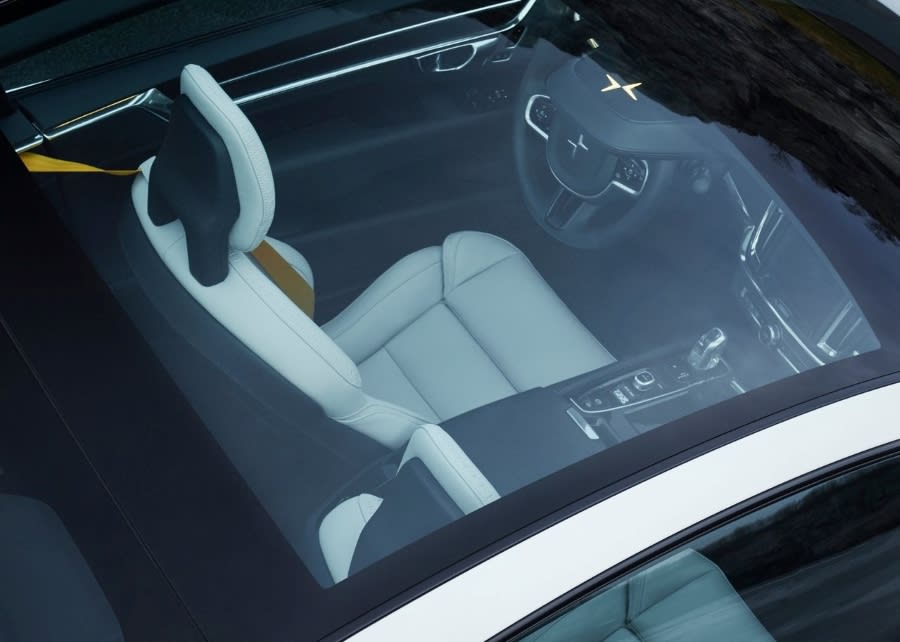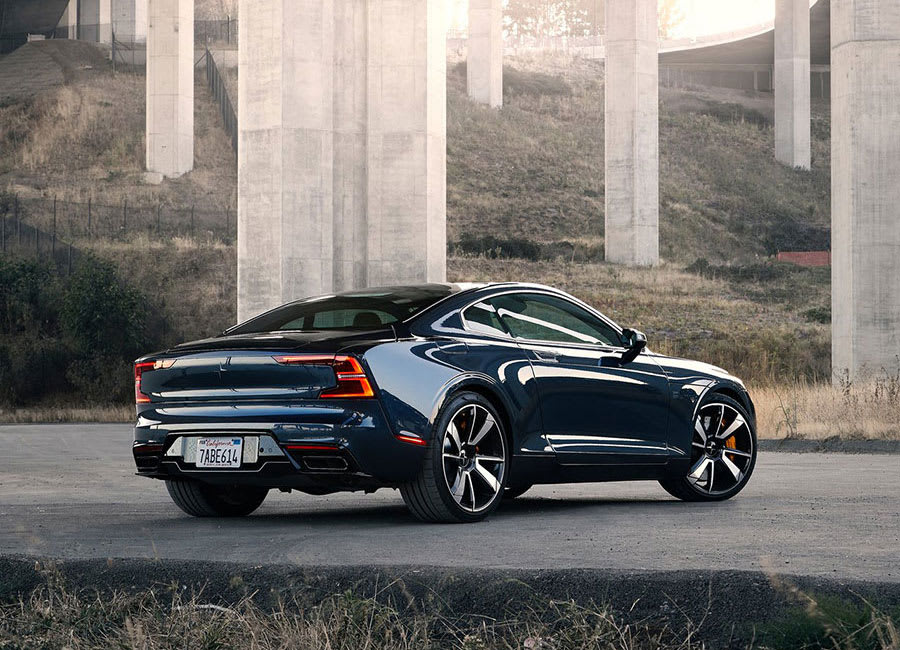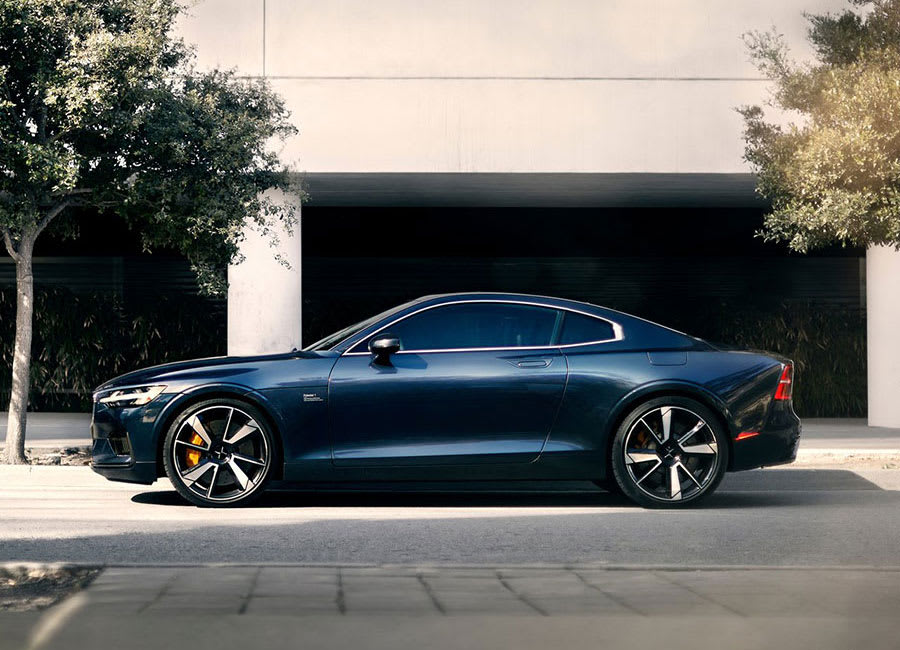.jpg)
Polestar 1 Review
.jpg)
Introduction
Once a Volvo skunkworks building high-performance versions of mundane saloons and estates, Polestar has emerged as its one standalone brand. Although it’s supposed to specialise in electric vehicles, Polestar’s first car, imaginatively named Polestar 1, is a plug-in hybrid sports coupe.
With bags of power, gorgeous design and a classy, well-appointed cabin, the car is intended to be a halo product for the brand – a technological showcase if you will. But the 1,500 vehicles Polestar has built can only fulfill that brief if they’re good at what they do. Spoiler alert: they are.
Review Sections
Select's rating score* - 3.8 / 5
At a Glance
Polestar isn’t mucking about with the 1 – a car that goes straight for the jugular among the world’s best-known grand tourers. This gorgeous coupe has a 609hp plug-in hybrid powertrain under its stunning bodywork, and the bodywork is almost entirely made from carbon fibre. It’s a new take on the classic GT car, but it works.
Hybrid power gives it the ability to be a rip-roaring performance car when the mood takes you, but it’s also capable of being an ultra-modern, eco-friendly electric coupe when it needs to be. That’s something few of its rivals can claim to achieve.

Key Features
One look at the Polestar is all you need to fall in love with this car. The styling is absolutely sublime, from the gaping front grille to the swooping rear haunches. The car is a development of Volvo’s already-outstanding styling, and it’s designed to be a spiritual successor to the P1800 made famous in The Saint. Whatever its heritage, the Polestar 1 is gorgeous, and it’s sure to turn heads wherever it goes.
The beauty continues inside, where the cabin is adorned with striking yellow seatbelts and a crystal gear selector. There’s a Polestar star in the ceiling, too, while the huge glass roof panel allows plenty of light into the cockpit. And if you open the boot, you’ll find a perspex panel covering a range of heavy-duty electrical connectors. With orange connectors, it’s a surprisingly attractive feature that highlights the car’s high-tech nature.

Range & Batteries
The Polestar’s hybrid system is quite involved, but key to it all is a 34 kWh lithium-ion battery. That’s very nearly as big as the battery in the all-electric Honda e city car, so it’s no surprise to find the 1 has bags of zero-emission range. Officially, a full charge will get you 77 miles without ever needing the 2.0-litre petrol engine up front. Of course, that depends on your driving style and the prevailing conditions. So while there’s no doubt 77 miles is fanciful for most drivers, most should manage 40 or so without breaking sweat.
Performance & Drive
To dismiss the Polestar 1’s powertrain as merely a conventional plug-in hybrid is to sell it short, but the basic principle is the same. There’s a big battery and electric motors for zero-emission, climate-conscious driving, and there’s a petrol engine to provide the flexibility of internal combustion. You can recharge the battery as you see fit, allowing you to run the Polestar as an electric car on short journeys, then use the petrol engine when you want more performance or a longer range.
That’s the basic idea, but the 1 executes this with more than a little panache. There are two electric motors on the rear axle, while the 2.0-litre petrol engine that drives the front wheels is both turbocharged and supercharged. Oh, and it comes with an integrated starter generator to provide an extra 68hp. Keeping up? Good. Not that it matters much. The really important thing is this: the 1 is a 609hp, four-wheel-drive coupe that gets from 0-62mph in about four seconds and on to an electronically limited top speed of 155mph. It might not be the simplest way of going quickly, but it’s certainly effective.

With the electric motors on hand, the car surges forward with every squeeze of the accelerator. After the initial wave of power, the petrol engine catches up, adding its might to the mix. That gives the 1 this irrepressible aura, an impression that it simply can’t stop accelerating, despite the fact it isn’t that noisy.
Thankfully for licence holders everywhere, easing off the throttle will slow things down, leaving you to enjoy what’s generally quite a relaxed driving experience. The ride has a stiff edge to it, but the seats are comfortable and the suspension is supple enough to stop the Polestar feeling too jarring. On a motorway, it’s a perfectly amiable cruiser.
That means the Polestar loses a little edge when it comes to handling, but there’s still lots of agility to play with. Although the car is based on Volvo S90 underpinnings, carbon-fibre components have been used extensively in a bid to ensure you can throw it around. Unfortunately, the car still weighs more than two tonnes and the hybrid system means the power delivery isn’t always as predictable as you might hope. Nevertheless, there’s a nice balance about the 1, and there’s plenty of grip on offer, so fast cornering is eminently possible, if not especially rewarding.

Around town, the car takes on a slightly different character, with the silent electric motors giving the car an eerily futuristic feel. It’s a bit of a goldfish bowl, though, because the stunning looks will turn heads wherever you go. This must be one of the best-looking cars in town.
But although it’s pretty, it has flaws. Not only does the 2.0-litre petrol engine feel a bit stingy alongside V6 and V8 rivals, it’s also lacking any aural excitement. It doesn’t sound bad, but it isn’t interesting or stirring in any way. The fact the Polestar is only available in left-hand drive might put some potential customers off, too.
Charging
The Polestar 1 can, in theory, be charged using anything from public charging points to domestic plugs, but Polestar suggests installing an AC ‘wallbox’ charging point at home. With a dedicated charging point at home, you can top up your car’s battery in just a few hours, giving it 77 miles of zero-emission motoring. To find out more head to our Understanding Electric Vehicles guide page.
If you have an electric car-friendly tariff, you can find yourself spending next to nothing on electricity. So if you mostly do short trips, the 1 is a very cheap grand tourer to run. However, whenever and wherever you do it, charge the car whenever it’s practical to make the most of that multi-faceted, multi-talented powertrain.
Running Costs & Emissions
How much the Polestar costs to run will largely depend on how you use it. Making the most of its power and four-wheel-drive system, failing to charge regularly and travelling long distances will all make it thirstier than the official 470.8mpg economy. Yes, you read that right. Keep most of your journeys short, charge regularly and generally treat the Polestar like an electric car with a get-out-of-jail-free card and that’s what they reckon you could manage. Not bad, is it?
Realistically, though, you probably won’t get anywhere near. But if you use electrical power as much as possible, you can get some solid economy figures from the 1.

Perhaps more importantly, you can get some good tax breaks from a plug-in hybrid like this. According to the WLTP economy test, this car emits just 13g of carbon dioxide for every kilometre it travels. That, combined with the 77-mile electric range means the car slots into the 4% company car tax bracket. Of course, that’s only useful if you can get the Polestar 1 as a company car. But if you can, it’s a boon compared with the Bentleys and BMWs against which the 1 is competing.
Interior & Technology
If you’ve ever driven a modern Volvo, you’ll find the Polestar 1 cabin very familiar. Pretty much everything in there has been taken from the Swedish sister brand, from the steering wheel to the switchgear and from the seats to the satellite navigation. But that’s no bad thing, because Volvo makes a mean interior these days. The quality is every bit as high as you’d get from a modern Lexus or a Jaguar.
The design is minimalist, with little in the way of buttons, so almost everything is delegated to the big portrait-orientated touchscreen. That isn’t a problem per se – the screen is quite easy and intuitive to use, and it responds quickly to any inputs, but it’s less convenient than just having a switch on the dash. If nothing else, screens require you to take your eye off the road.

That aside, the on-board technology is generally very good. The digital instrument display is crystal clear and the Bowers & Wilkins sound system is brilliant. The reversing camera is also great, although the satellite navigation system leaves something to be desired. But that’s no matter, because the standard-fit Android Auto and Apple CarPlay smartphone integration systems are much better and much easier to use.
As these images show, the steering wheel is on the left. That isn’t just because we tested a foreign car, but because all Polestar 1s are left-hand drive. It’s no issue once you’re used to it, but it can make visibility tricky at times. And until you do get accustomed, you’ll spend ages walking around the car after trying to open the wrong door.
Practicality & Boot Space
The Polestar 1’s boot is not especially large, at 126 litres. That’s smaller than you’ll get in a Fiat 500, and it’s even smaller than a Mazda MX-5 – one of the least practical cars out there. Fortunately, the boot is more accessible than the MX-5’s, thanks to a wide aperture through which you can shove your stuff.
Sadly, you can’t even expand the boot by folding down the two rear seats because there’s a beautifully presented set of heavy-duty, high-voltage electrical connectors in a perspex case between the boot and the seats. It looks kind of cool, but it’s pretty useless.

Even the rear seats can’t profess to be that bad, although they do come close. Only children will be able to fit back there, with very limited head- and legroom for adult passengers. On the plus side, not being able to put passengers back there means you can use the space as a kind of second storage area. There’s more than enough room for overnight bags and other luggage in there.
Don’t think the Polestar is all bad, though. Because the forward cabin is pure Volvo, it has Volvo practicality with handy cubby holes and decent-sized door bins. There’s plenty of head and legroom for those in the front, and the whole cabin feels airy thanks to the standard-fit glass roof.
Safety
The Polestar 1 hasn’t been crash tested, but we’d be shocked if it wasn’t a five-star car. This is a coupe with Volvo DNA, and the Swedish brand has safety in its blood. If you’re worried, take comfort from the fact this is based on the Volvo S90, which is a five-star car, and its sibling, the Polestar 2 electric vehicle, also managed the full five stars.
For further comfort, look at the equipment list. The Polestar 1 is rammed with technology to help prevent accidents happening in the first place, and that’s the safest way to go about things in our book.

To that end, the 1 comes with a system that can automatically swerve to avoid a crash, as well as cruise control that maintains a safe distance to the car in front. The car will even keep itself centred in its lane to reduce the driver’s workload, and there’s a blind-spot monitor to alert you when another vehicle is lurking in one of the blind spots over your shoulders.
Options
Picking your Polestar 1 is pretty simple. There are no trim levels to choose from, just a simple list of options, most of which are aesthetic upgrades. And even then, your options are fairly limited.
You can have one of five colours, although you do get to choose whether you want the finish to be metallic or matte, and you can pick chrome or black trim for the exterior. Add in a choice of three alloy wheel designs and two seat upholstery colours, and that’s pretty much it.
Fortunately, the Polestar 1 gets plenty of equipment as standard. You get 21-inch alloy wheels, LED headlights and an ‘active’ rear spoiler that’s raised and lowered as required for optimum aerodynamics.

Inside, the 1 comes with sports seats trimmed in Nappa leather, carbon-fibre dashboard inlays and a crystal gear selector. Two-zone climate control, heated front seats and a heated steering wheel are also thrown in, along with a digital instrument cluster, touchscreen infotainment system and a Bowers & Wilkins sound system.
With standard-fit satellite navigation, a 360-degree parking camera and the Apple CarPlay and Android Auto smartphone integration technology, it’s a fully laden spec sheet. But then it should be, because this car has a list price of almost £140,000.
What would we choose? Metallic Midnight paint with chrome trim, the standard-fit diamond-cut alloy wheels and black leather. You can thank us later.
Rival Cars
The Polestar 1 is hard to pigeon-hole, with few direct rivals. Try finding another plug-in hybrid grand touring coupe with roughly 600hp and a six-figure price tag. The best you’ll probably get is the Porsche Panamera, which definitely isn’t a coupe, but it’s available as a hybrid. It’s an incredible bit of kit, though.
Other than that, you’re looking at fully electric vehicles such as the Porsche Taycan and Audi e-tron GT, or conventionally powered models. The Porsche 911 is the yardstick for all sports cars, while the Aston Martin Vantage, Mercedes-AMG GT and BMW 8 Series are all brilliant, if a little more sporty than the Polestar. Perhaps the Bentley Continental GT is a better comparison in terms of the balance between sportiness and comfort?
But maybe we shouldn’t compare this car with what is already available. As time goes on, it seems more likely that we’ll see this kind of hybrid technology powering the world’s grand tourers, and the rivals will grow. By then, the Polestar 1 will be a limited-edition collector’s item, but it will also be the trailblazer. It might just do for coupes what the Mitsubishi Outlander PHEV did for SUVs.
Verdict & Next Steps
There’s no doubting the Polestar 1’s capability. This is a luxury grand tourer with great performance, a comfortable ride and a suave shape. But it’s a car with a conscience. A long zero-emission range makes it economical, with short journeys carried out on electric power alone.
But this is a car for long drives; it’s a coupe that swallows motorway miles with ease, then slinks silently and responsibly around the city centre. For some customers, that’s the stuff of dreams. For those who drive a Polestar 1, it’s a reality.
Where to next?
View latest Polestar 1 leasing deals here
Looking for a great leasing deal? Check out our incredible range of Special Offers
New hybrid or electric car? Read our latest Reviews and find the right model for you
Want to know more about electric leasing? Take a look at our comprehensive Leasing Guides
Interested in everything motoring? Why not catch up on all the latest Car Leasing News.
*Score based on Select’s unique meta score analysis, taking into account the UK’s top five leading independent car website reviews of the Polestar 1




















